Creative Problem Solving Examples That Solved Real World Problems

Not all problems have simple, straightforward solutions. And the more we try to solve these problems with basic techniques, the worse the problems get. Real-world problems are messy and complicated, and they require a creative approach to problem solving. In this post, we’ll share a range of real-world creative problem solving examples from the human-centred design work of Overlap Associates.
When there isn’t a straightforward answer, it’s time for another approach—one that puts all of the people involved at the forefront of decision making.
What is Creative Problem Solving?
Creative problem solving applies human-centred design principles, practices, and tools to complex problems, enabling individuals, teams, and organizations to unlock innovation and navigate uncertainty in a rapidly changing world. It’s all about tapping into the unknown to uncover brand new solutions—ones you’ve never thought of before or didn’t know were possible.
The more complex a problem is, the more nuanced and layered the solution needs to be. Creative problem solving requires that you separate divergent thinking (idea generation and brainstorming) from convergent thinking (idea evaluation and decision making) as opposed to trying to do both at once.
Creative problem solving involves gathering observations, asking questions, and considering a wide range of perspectives. It encourages better critical thinking, collaboration, communication, and last but certainly not least, creativity.
Let’s discuss complex, real-world problems that were solved using creative problem solving and human-centred design techniques.
Creative Problem Solving Examples
Example #1: Adapting Customer Service to Evolving Customer Expectations and Needs
The Complex Problem:
Customer service always has room for improvement, and the insurance industry is no exception. Tensions run high when receiving claims, and it is critical that customers feel both comfortable and satisfied with the claims experience. Gore Mutual was at a standstill with a 97% customer satisfaction rating, but the company wanted to do more. As customer expectations and needs continue to evolve, how can customer service continue to improve?
Creative Problem Solving Methods:
In order to improve customer satisfaction, Gore Mutual first needed to understand the experiences of all relevant stakeholders in the claims process, which included customers, brokers, and service providers. Acknowledging the role of each group in the overall claims experience would create a clear customer journey.
Overlap led a series of engagement sessions and gathered feedback from all groups involved in the customer journey to better understand where the journey could be improved. Methods of information gathering included in-person interviews, interactive Stakeholder Lab workshops, and observational research of spaces, such as dispatch centres, digital platforms, contractors’ shops, and customer meetings.
This thorough approach went beyond simple satisfaction surveys to paint a detailed picture of the entire customer journey. A Journey Map, a design tool for capturing new ways of looking at someone’s experience, was used to guide research collection.
In the end, a nuanced insights report was created to outline the current and ideal future state of navigating the claims process. With this ideal claims journey in mind, Gore Mutual established ClaimCare, a new approach to claims processing, which included improvements such as a Concierge for inquiries, a Mobile Response Team, and a Mobile Response Centre for catastrophes.
Learn more about the Service Design Project with Gore Mutual Insurance.
Example #2: Developing Inclusive Online Facilitation in the Midst of a Pandemic
The Complex Problem:
The beginning of the pandemic left businesses scrambling to find inventive ways to hold in-person meetings and events. How do you create engaging facilitation without experiencing the intangible moments that come with face-to-face, in-person connection? How do you develop online facilitation that’s engaging and accessible to everyone in the midst of overwhelming Zoom fatigue? How do you implement technology in order to be effective while also not alienating those who are unfamiliar or struggle with new technology?
Creative Problem Solving Methods:
Like many businesses, The Schlegel-UW Research Institute for Aging (RIA) was caught in the dramatic shift to online methods that occurred in the early days of the pandemic. They knew they needed to adopt new technology in order to thrive—or even survive—but they didn’t want engagement to suffer or for those less technologically inclined to be left behind.
Using the lens of creative problem solving and human-centred design techniques, RIA was able to translate all they previously knew about facilitation into an adaptive and inclusive online approach. It was essential to find tools and solutions that were simple to navigate and accessible to everyone on the RIA team, as well as those RIA works with.
Overlap provided these tools and the training required to implement online facilitation quickly and effectively while sharing insight into how to spot unconscious bias, how to lead an accessible session, and how to apply diversity, equity, and inclusion across all online communication. Keeping human-centred design principles top-of-mind ensured all voices were heard, and no one was left behind in the transition.
Learn more about Developing New Training for Great Online Facilitation.
Example #3: Improving the Experiences of Aging Adults
The Complex Problem:
Aging is a deeply personal and challenging experience. How can caregivers better understand the experiences of older adults? Instead of grouping every senior together, how can care be designed to meet the needs of all subgroups of aging adults? For example, newcomers, people who identify as LGBTQ+, and people with dementia may require or prefer different methods of service.
Creative Problem Solving Methods:
To solve this complex problem, Overlap deployed design teams to complete high-touch, day-long ethnography as well as low-touch, three-minute surveys to gather a wealth of data that could inform decision making. Overlap used the findings and insights to develop a thorough and wide-ranging set of design principles for serving older adults.
A comprehensive toolkit was designed to help service providers co-design alongside older adults. The toolkit included practical, creative problem solving techniques and guided design thinking practices to ensure everyone affected was involved in the process. In addition to the toolkit, training was provided directly to caregivers to ensure all gaps in service and understanding were bridged.
Directly involving aging adults from all walks of life, their loved ones, and their caregivers meant the decision making process was thoroughly informed, which enabled care to be adapted to meet the needs of all individuals.
Learn more about the Aging By Design Project in New York State.
Learning More About the Creative Problem Solving Process
Overlap’s Creative Problem Solving School has a suite of courses that have been carefully designed to bring design thinking training to anyone ready to learn. We share tools and strategies that will help you and your team make better decisions.
Our wide range of courses include practical and engaging materials that will help you work better together, understand your customers, and navigate complex challenges.
The Exploring Complex Problems (201) course focuses on how to solve complex, real world problems using creative problem solving methods. It’s a deep dive into the Define and Research phases of the human-centred design cycle and demonstrates why remaining in the problem space and iterating between these two phases creates a strong foundation for ideation.
Learn more: Why Every Team Needs Human-Centred Design Training.
If you want to continue developing your creative problem solving skills, follow us on social media and sign up for our monthly newsletter to stay informed about our latest training schedule, new courses, and free resources.

0 comments
Leave a comment
Please log in or register to post a comment